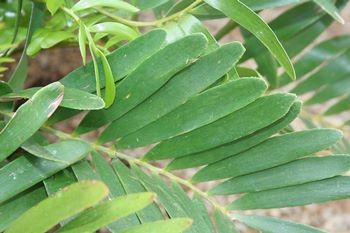Coontie Florida Arrowroot
(Zamia pumila)

Description
Zamia integrifolia, also known as coontie palm is a small, tough, woody cycad native to the southeastern United States (in Florida and Georgia), the Bahamas, Cuba, the Cayman Islands, and Puerto Rico. Zamia integrifolia produces reddish seed cones with a distinct acuminate tip. The leaves are 20–100 cm long, with 5-30 pairs of leaflets (pinnae). Each leaflet is linear to lanceolate or oblong-obovate, 8–25 cm long and 0.5–2 cm broad, entire or with indistinct teeth at the tip. They are often revolute, with prickly petioles. It is similar in many respects to the closely related Zamia pumila, but that species differs in the more obvious toothing on the leaflets. This is a low-growing plant, with a trunk that grows to 3–25 cm high, but is often subterranean. Over time, it forms a multi-branched cluster, with a large, tuberous root system, which is actually an extension of the above-ground stems. The leaves can be completely lost during cold periods, with the plant lying dormant in its tuberous root system, allowing this cycad to be relatively cold hardy. The plant can survive up to USDA region 8b (10° to 20° F). The stems and leaves regenerate after the cold period subsides with full foliage. Like other cycads, Zamia integrifolia is dioecious, having male or female plants. The male cones are cylindrical, growing to 5–16 cm long; they are often clustered. The female cones are elongate-ovoid and grow to 5–19 cm long and 4–6 cm in diameter. Zamia integrifolia inhabits a variety of habitats with well-drained sands or sandy loam soils. It prefers filtered sunlight to partial shade. Populations are presently limited to Florida (including the Florida Keys) and southeastern Georgia in the United States, western Cuba, the Bahamas (on Andros, Grand Bahama, Great Abaco, Long Island, and New Providence islands) the Cayman Islands, and one small population on south-central Puerto Rico. Controversy has long existed over the classification of Zamia in Florida; at one extreme all the American populations are included in a broadly defined Zamia pumila species complex, and at the other several species have been recognized under various names (e.g., Z. augustifolia, Z. floridana, Z. silvicola, and Z. umbrosa). The Flora of North America treats all of the American populations as Z. integrifolia, and all West Indian populations as other species. Genetically, the differences between populations cannot be explained by habitat variability.
Taxonomic tree:







